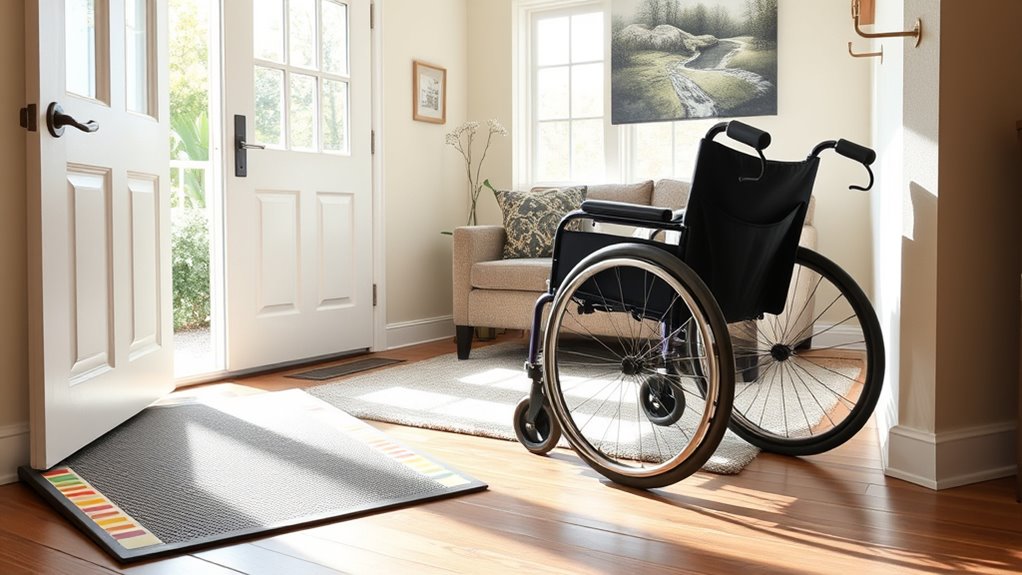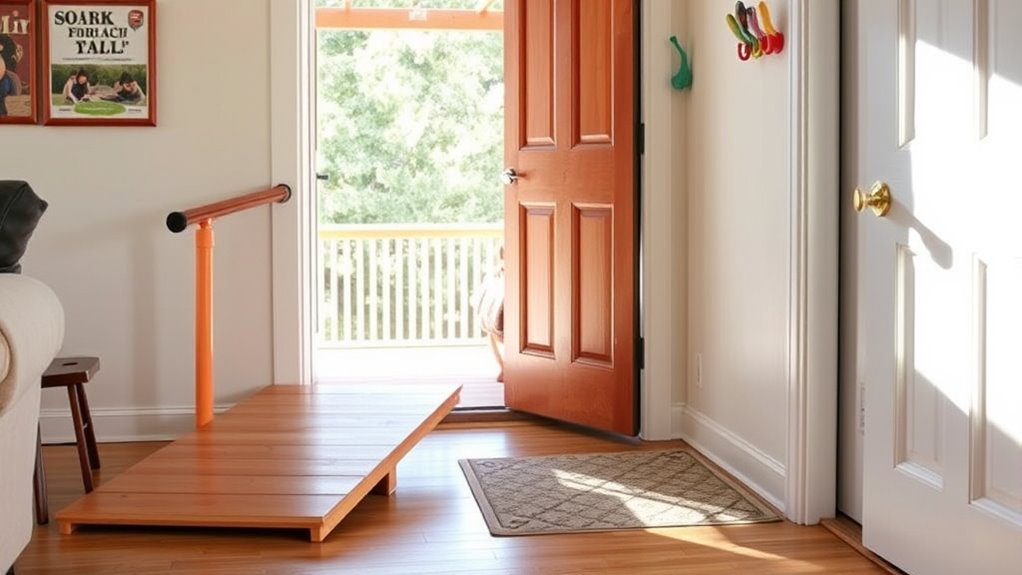You can make your home more accessible without spending a lot by using simple DIY upgrades and smart tech solutions. Consider widening doorways, replacing knobs with lever handles, and removing thresholds to create easier pathways. Install affordable smart bulbs, motion sensors, or voice-activated devices to boost safety and convenience. Adding grab bars or reorganizing furniture can also help. With a few small changes, your space becomes safer and more functional—keep exploring for more ideas to improve accessibility on a budget.
Key Takeaways
- Use affordable smart home devices like voice-activated lights and smart locks to enhance accessibility easily.
- Re-arrange furniture and remove obstacles to create clear, unobstructed pathways without spending much.
- Install lever-style door handles and remove thresholds for easier door operation on a budget.
- Upgrade lighting with motion sensors or adjustable fixtures to improve safety and visibility affordably.
- Add DIY bathroom modifications such as grab bars and shower seats to boost safety without high costs.

Are you considering upgrades to make your home more accessible? If so, you’re in the right place to explore budget-friendly options that don’t compromise on style or functionality. One of the most effective ways to enhance your home’s accessibility is by integrating a smart home system. Smart devices like voice-activated lights, thermostats, and doorbells can make daily routines smoother and safer, especially for those with mobility challenges. You don’t need to spend a fortune on expensive tech; many affordable options exist that are easy to install and operate. For example, smart bulbs can be programmed to turn on automatically when you enter a room, reducing the need to fumble with switches, especially at night. Smart locks can replace traditional keys, providing keyless entry and making it easier for everyone, including caregivers or family members, to access your home without hassle.
Upgrade your home with affordable smart devices like voice-activated lights and keyless locks for safer, easier living.
Incorporating universal design principles is another cost-effective way to improve accessibility. Universal design aims to create environments that are usable by everyone, regardless of age or ability. Simple modifications like widening doorways or removing thresholds can make a significant difference. You can do this yourself by removing old door stops or adjusting hinges to ensure smoother passage. Installing lever-style door handles instead of knobs is a small change that offers big convenience, especially for those with limited grip strength or arthritis. Additionally, consider re-arranging furniture to create clear, unobstructed pathways—this often requires only repositioning items you already own. Using low-profile rugs or adding non-slip tape to slippery surfaces can prevent falls without a hefty investment. Upgrading lighting with motion sensors or adjustable fixtures can also enhance safety and ease of use. Implementing remote monitoring or alert systems can further increase safety for those with mobility limitations or health concerns. Moreover, understanding Juice Packaging and Storage best practices can help ensure that any food or beverage upgrades you make are safe and effective.
Another budget-friendly tip involves upgrading bathrooms, since they’re common trouble spots for accessibility. You can replace existing fixtures with more accessible options, such as installing grab bars and a handheld showerhead. These upgrades are generally affordable and straightforward to install if you follow instructions carefully. Adding a shower seat or bench can also improve safety and comfort without breaking the bank. For kitchens, consider installing pull-out shelves or cabinet organizers that make reaching items easier and reduce the risk of accidents. Simple DIY projects like these can dramatically improve usability without requiring major renovations. Additionally, exploring smart home technology options can further customize your space for accessibility needs, making everyday tasks easier and more efficient.
Lastly, take advantage of online tutorials and local hardware store advice to guide your DIY upgrades. Many products designed for accessibility are user-friendly and come with detailed instructions. With a bit of effort, you can transform your home into a more inclusive space—saving money while making everyday life safer and more comfortable. Remember, small changes can have a big impact, and you don’t need to spend a lot to create a welcoming, accessible home for everyone. Additionally, understanding the role of technology in home accessibility can help you identify innovative solutions to meet your specific needs.
Frequently Asked Questions
What Are the Best Budget-Friendly Tools for DIY Accessibility Upgrades?
When choosing tools for DIY accessibility upgrades, you want options that are effective and affordable. Portable ramps are essential for creating easy access, and grab bar kits are perfect for added safety. These tools are budget-friendly, easy to install, and widely available at hardware stores. With these, you can improve your home’s accessibility without breaking the bank, making your space safer and more comfortable for everyone.
How Can I Assess My Home’s Specific Accessibility Needs Effectively?
You might think evaluating your home’s accessibility needs is a breeze, but don’t be fooled—an honest home assessment is key. Start with an accessibility evaluation by walking through each space, noting obstacles or areas that could pose challenges. Ask yourself questions about daily routines and future needs. This thorough approach ensures you identify real issues, making your DIY upgrades more effective and tailored to your home’s specific accessibility requirements.
Are There Any Grants or Financial Aid Options for Home Modifications?
You might wonder if there are government grants or financial aid options for home modifications. Yes, many programs offer assistance to help cover the costs of accessibility upgrades. You should check with local and federal agencies, like the Department of Housing and Urban Development or state programs, to find available grants. Applying is usually straightforward, and these funds can considerably reduce your out-of-pocket expenses while making your home more accessible.
How Long Do DIY Accessibility Upgrades Typically Take to Complete?
When planning your DIY accessibility upgrades, you’ll want to think about your timeline and skill assessment. Typically, these projects can take anywhere from a few hours to several weekends, depending on complexity. You should break down tasks and set realistic deadlines. Assess your skills honestly to avoid delays. With proper planning and effort, you can complete upgrades efficiently, ensuring they’re safe and effective for your home.
What Safety Precautions Should I Consider During DIY Home Modifications?
Did you know that falls are the leading cause of injury in home DIY projects? When doing home modifications, always prioritize safety. You should focus on fire safety by installing smoke alarms and keeping fire extinguishers nearby. Be cautious of electrical hazards—turn off power when working on wiring. Use proper tools, wear safety gear, and never rush. These precautions protect you and make your home safer during every DIY upgrade.
Conclusion
By making these budget-friendly upgrades, you’re opening a door to greater independence and comfort. Think of your home as a sturdy bridge, connecting you to daily freedom and safety. Each small change is like planting a seed—growing stronger, more accessible with every step. With a little effort, you’re transforming your space into a welcoming haven where confidence and ease flow freely, lighting the path toward a more independent, fulfilling life.









